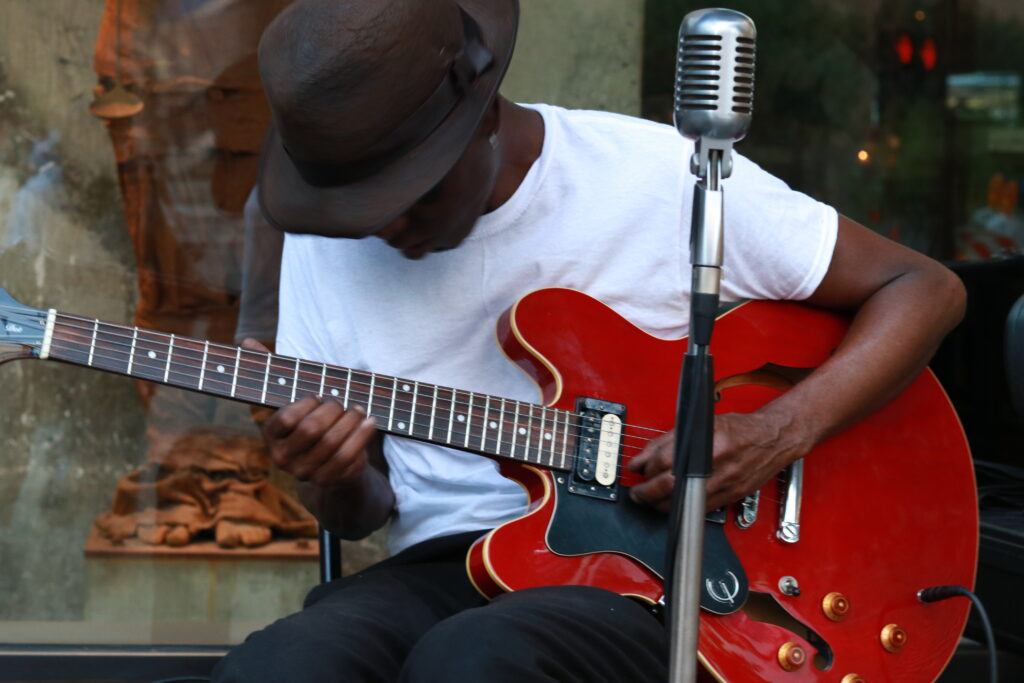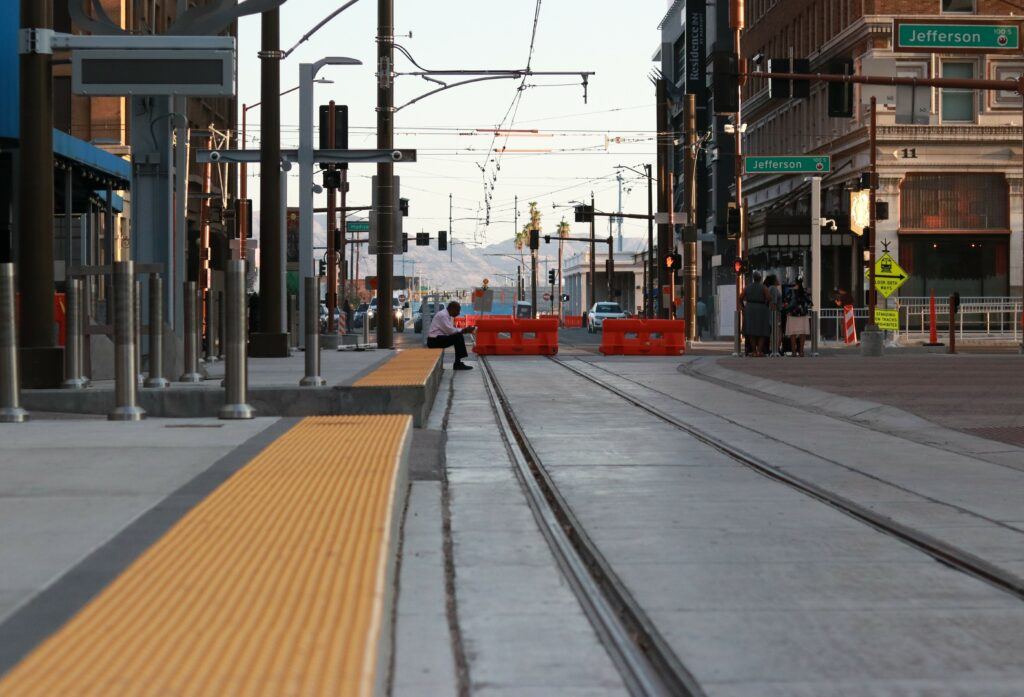Street photography is an exploration of human nature; capturing brief moments that tell stories. This art form thrives on spontaneity, offering a window into the soul of a city and the people who live there. Mastering street photography requires not only technical skills, but the ability to observe people and connect with the world around you.
The Appeal of Street Photography
At its core, street photography is about capturing images that reflect the present moments, conditions, and people at a particular place and time. These can be a strangers smile, a busy marketplace, a worn down building, or even a newspaper left on a bench.
This type of imagery offers raw and authentic snapshots of life as it happens, making it a compelling visual narrative of human behavior, culture, and emotion.
This can be accomplished through taking photos of any particular scene that is happening on the Street. Of which can include only the environment….or the environment and people in it. There is definitely a difference between taking pictures of buildings, stationary objects, etc. and people.
So- let’s take a look at the best Street Photography Tips for Capturing those candid moments. Those involving people.
Differentiating Between Posed and Candid Photography
Posed photography requires asking someone permission to take their picture. You may also need to provide them with a bit of guidance if you see they are uncomfortable. The person is fully aware of your presence.
In comparison, candid photography is about the element of surprise, and taking someone’s picture without any interference. The authenticity of these spontaneous moments is what gives street photography its charm.
Posed photos are referred to as Street Portraiture- and they do have their place. Up to this point, I’ve taken more of these than candid’s. Candid shots do tell more of a story though that feels real and relatable.
Then- there’s a combination of these two. I took a picture of a gentleman playing a guitar in Downtown Phx. I asked him first- and then he went about just playing his guitar. He was looking at the guitar strings so I think he forgot I was even there. To me- I don’t think this looks posed. What do you think??

Art of Acting
Getting a great candid shot of someone typically requires that you get close enough to actually see them. You want to get close them as possible while being inconspicuous. This means acting. Pretend you don’t even notice the people right in front of you.
You do not want to make eye contact or move your head in their direction. Something about looking towards someone will make them notice you right away.
What you want to do is look through the person- as if you are looking at something to the side or slightly behind them. This will make you look aloof or that you’re truly involved in something else.
There are some photographers who will fumble on purpose and act as if they don’t know the settings on their camera. Then- will take the image when the person is completely unsuspecting.
These strategies may seem like trickiery , but if you want to get solid, award winning shots through your career as a Street Photographer some of the techniques may be necessary.
Now, with this said, I haven’t used the strategy…. yet. At this point, I am more comfortable asking people for their permission for those up close images.
Developing an Eye for Storytelling Through Candid Moments
To excel in street photography, you must train your eye to recognize stories in what could be considered ordinary moments. We see people all the time, doing every day things. I think through being genuinely interested in people, it can help tremendously in building this skill of storytelling. You need Intuition and empathy and be able to observe details like expressions, body language, and the context of the situation.
One vein of observation is to keep your eye out and anticipate when people will gesture. Do this by watching their body language. Taking a picture of someone doing something (shaking their fist, smoking a cigarette, or talking on the phone) is more interesting than a lady coming out of a store with shopping bags.
Learn to anticipate moments before they happen. If you go out often enough, you’ll start to understanding the rhythm of the streets. You can study how people interact with their surroundings, and patiently observe. There are some street photographers who will wait in one spot for hours to have one person walk into the scene.
I took this image of a guy sitting down next to the Metro Rail. In this case, I did not ask his permission. He did not know I took his picture. ( I am still building up courage to take candid’s up closer).
To me, the story is that he’s resting after shopping with a group of lady friends/family members. I made this reference in regards to the ladies to the right of him. I could be completely wrong, but this is my picture, my story. ;-P

As you get out there and practice, you will get better and better at developing your eye for storytelling . This means no couch visualization- get out there for Real! The more you shoot, the better you’ll become at noticing those perfect, split-second opportunities.
Studying work from iconic street photographers like Cartier-Bresson and Vivian Maier can also offer insight and inspiration. What’s crazy about Vivian is that the majority of her work wasn’t discovered until after her passing. Her work is incredible!
Learn from the masters, but develop your own unique style. After all, it’s your view of the world that will make your street photography stand out.
Choosing the Right Camera and Lens
You want to be mobile and discreet as possible with Street Photography. Sometimes people can freeze up and act funny when they see someone that has a camera other than a camera phone.
If possible, get a camera that’s portable, unobtrusive, and capable of capturing high-quality images. Compact mirrorless cameras or smaller DSLRs are popular choices because they offer excellent image quality without being too bulky. ( I have my Canon 80D which is bulkier than I prefer. At some point, I will definitely get a sleek, smaller mirrorless camera). And- this is not landscape or wildlife photography so leave the tripod at home. 🙂
When it comes to lenses, a prime lens with a focal length between 35mm and 50mm is an excellent choice for capturing candid shots at a comfortable distance while maintaining a natural perspective. A zoom lens can be versatile, but primes are often preferred for their lightweight design and will encourage you to move around more and get closer.
Gaining Confidence
Street photography can be intimidating, especially when it involves photographing strangers. Getting more confident takes time, but the key is to practice often and remember that most people won’t even notice you’re photographing them.
If they do notice you, just smile and let them know you’re a Street Photographer. This can go a long way in defusing any awkwardness. When you approach the streets with respect and empathy, your photos will reflect that.
Legal and Ethical Considerations in Street Photography
Understanding Legal Implications and Rights for Photographers in Public Spaces
Photographers generally have the right to photograph people in public spaces, as long as they’re not violating any specific privacy laws. However, laws vary by country and region, so it’s important to research the regulations wherever you’re shooting. In many places, you can take photos in public spaces without explicit permission, but restrictions may apply in private properties, government buildings, or in situations involving children.
Respecting Privacy and Cultural Sensitivities While Photographing
Even though street photography is legal in most public spaces, there are ethical considerations to keep in mind. Always respect your subjects’ dignity and privacy. If someone expresses discomfort or asks you not to take their photo, it’s best not to. Similarly, be mindful of cultural differences, as certain practices or behaviors may be considered invasive or offensive in different contexts.
Street Photography Tips For Capturing Candid Moments Summary
Mastering street photography takes practice, patience, and a genuine interest in people and the world around you. It is exciting to know that as a photographer you are adding value to the world through capturing present moments. These images will be available for future generations so they can see what life was like.
With the right mindset, technical know-how, and respect for your subjects, you can create powerful images that tell compelling stories of the streets.